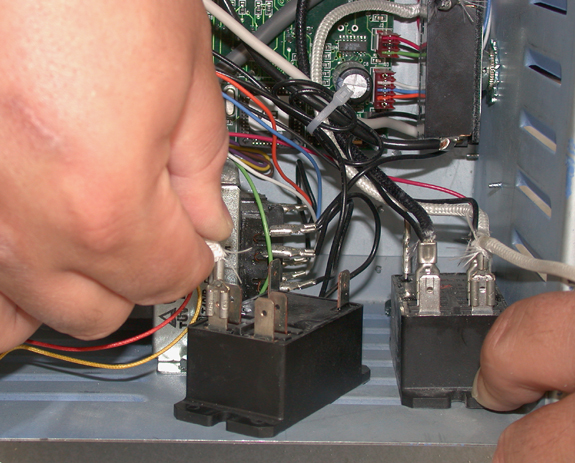 |
|
|
Kiln Pointers
|
|
|
The Relays Inside a Kiln |
CONTENTS The Relays Inside a Kiln Reader Response: Over-fired clay Recent Q&As: Glass fusing paint; life expectancy of kiln wash A Kiln Story: Replace Only Needed Parts ----------- THE RELAYS INSIDE A KILN Earlier this month I taught kiln maintenance classes at the Weisser Glass Studio and the Vitrum Studio. One of the students brought a small digital Caldera kiln for me to check. I’ll share two pointers about relays that come from that experience. First, what is a relay? Digital kilns and some switch-operated kilns use them to turn on the heating elements. The digital controller sends a signal to the relays. Inside each relay, the power from the controller charges an electromagnet, which closes contacts that turn on the elements. This may be easier to understand if you experimented with electromagnets in high school science class. I remember wrapping a nail with wire at age 13. The nail became a magnet when the wire was hooked up to a battery. That’s how a relay works. A magnet inside the relay pulls contacts together. (To better understand how a relay works, take apart an old one you are replacing. You will find the electromagnet and the contacts.) The two pointers: 1) A relay may be burned out even if it still makes a clicking noise. A relay makes a clicking noise every time its electromagnet brings the contacts together. (Mercury relays are silent, however, because they don’t use mechanical contacts.) The kiln that I checked made a normal clicking noise as the relay operated. But the heating element didn’t turn on. I checked the relay with a voltmeter and discovered that it was burned out. 2) Most relays are held in place with two sets of nuts and bolts. When you replace a relay, check to see if it has slots or holes where the bolts fasten. If the relay has slots, remove only one bolt and nut. Loosen the other. Then slide out the relay from the loosened bolt. This will save you a lot of time especially if you are working in a cramped switch box. ----------- READER RESPONSE In the last Kiln Pointer I related the story of an instructor who over-fired ware because he didn’t know the students had purchased low-fire clay. Carole Dwinell of Martinez, California wrote, “The studio where I take classes has had that problem once or twice too, where students have brought in a piece to be fired that the instructor thought was made with studio clay. There are signs ALL over the studio saying NO OUTSIDE CLAY, and they sell only cone 10 clays. At the beginning of each session, they display a kiln shelf with an ugly mess of melt-down on it. Pictures are sometimes better than words.” ----------- RECENT Q&As From an August 28 Pointer: Q. In the Kiln Pointer that demonstrated Glassline paints, a pen was used. Where can I purchase one? A. You can buy the pen directly from the author, Larry Pile: Misteroldhouse@aol.com / www.kesslercraftsman.com Q. I've been having trouble with the coating on my kiln shelf lasting only one or two glass firings. It used to last five or six. The kind of kiln wash I use hasn't changed. I fire it the same. Any hints? A. The lower the firing temperature, the less the kiln wash (or glass separator) sticks to the glass. I have had half a dozen firings from one application of kiln wash on the shelf when firing to a mid-fuse. Sometimes you can lay small glass pieces on areas of the shelf that still have a good coating of kiln wash and avoid the areas where the kiln wash has flaked off. The higher the glass fusing temperature, the more often you need to apply the kiln wash. Some artists recoat the shelf after every glass firing. This is to avoid the possibility of laying glass over cracked or flaking kiln wash. ----------- A KILN STORY: REPLACE ONLY NEEDED PARTS Careful diagnostics can save money in replacement parts. Tony Rodriguez of San Antonio, Texas wrote, “A contemporary studio customer asked me to check her kiln. The complaint was that the bottom of the kiln was grossly under-firing. Someone had told her she needed to change the thermocouple, all the elements, and all the relays. Some of the LED lights in the digital display window were burnt, so some of the letters/numbers were hard to read. Again, she was told she had to replace the controller board, too. She had been using the kiln with the bad LED readouts for over a year without any firing problems until now. “When I checked the kiln,” Tony wrote, “the actual problem was only a bad relay for the bottom two elements. That accounted for the under-firing.” ----------- Have you ever noticed that no matter how many times you have fired a kiln, it is still exciting to open it? You never know exactly what you will find. Some of my favorite glass pieces were mistakes. Recently, glue discolored a bluish dichroic piece and gave it a silvery cast. It was an exquisite gift from the “kiln gods.” Thank you, With best wishes, Arnold Howard Paragon Industries, L.P. – Better Designed Kilns 2011 South Town East Blvd. Mesquite, Texas 75149-1122 Voice: 972-288-7557 & 800-876-4328 / Fax: 972-222-0646 ahoward@paragonweb.com / www.paragonweb.com PRIVACY NOTICE: Under no circumstance do we share or sell your email address. Copyright 2008, by Paragon Industries, L.P. |
|
|

|
|
|
|
|
“Custom and standard Kilns and Industrial Furnaces for ceramics, pottery, heat treating, enameling, |
||||
